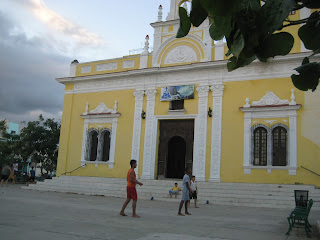This morning I was pointed in the direction of
a cool interactive map put out by the Yale Project on Climate Change Communication.
It allows you to view survey results about people's beliefs regarding global warming, their perceptions of the risks involved, and their support for various kinds of policy responses.
You can look at response rates for the nation as a whole, state by state, county by county, or by Congressional district.
You can learn that, nationally, 63% of respondents said "Yes" in answer to "Global warming is happening." And while that might seem dispiritingly low, you can look at your own Congressional district (NY 19) and see that you're beating the national average (well, by a touch, at 64%), or your county (Otsego) and see that you're beating the national average by even more (only a little more, at 65%), or your state, and take pride in New York's whopping 72%.
Hawaii has the most for a state, at 75%, bested by Washington D.C. at 81%—for some people, that might be just more evidence of how out of touch the capital is.
But what caught my eye was something else.
On the question, "Most scientists think global warming is happening," the national average is 41%. Remember, 63% of the country think that global warming is happening. Mathematically, that means there are at least 22% of the country who themselves think that global warming is happening, but also don't think that most scientists think it's happening.
And if you look at, "Global warming is mostly caused by human activity," the national average is 48%. So there are at least 7% of the country who think that human activity is the biggest cause of global warming, even though they don't believe that most scientists think it's happening at all.
This can be read as a testament to the success of the smoke-screen strategy.
John Oliver nailed this in one of his early episodes of
Last Week Tonight. The routine practice in journalism is to have someone explaining something about climate change based on the scientific consensus, and then to "balance" it with someone claiming that it's not happening, or something along those lines.
We respond strongly to visuals, and so the journalist can
say that there's an overwhelming scientific consensus that climate change is happening, and a very strong one that human activity plays a large role. But if your TV screen is showing you one person laying out the consensus position, and one person contesting it, what sticks in your emotional memory is something more like an unsettled question, a roughly even split of opinion.
In addition to the questionable journalism, there's the quite conscious strategy laid out in sources like
Merchants of doubt. In the face of anti-smoking efforts, the tobacco industry was able to get measures watered down and delayed by creating an image that there was lots of uncertainty among scientists about the negative effects of smoking.
Similarly, the fossil fuel industry has been managed to spread the idea that scientists have lots of uncertainty not only about whether humans play a significant role in climate change, but even about whether it's happening.
Only 41% of Americans understand that scientists think global warming is happening.
The merchants of doubt have been brilliantly successful.
At least 22% of the country thinks that global warming is happening,
even though they don't think scientists think that.
Imagine if 100% of the population knew the empirical fact that the vast majority of scientists think global warming is happening. In that case, how many people would agree that it's real?
How many would support doing something about it?




















